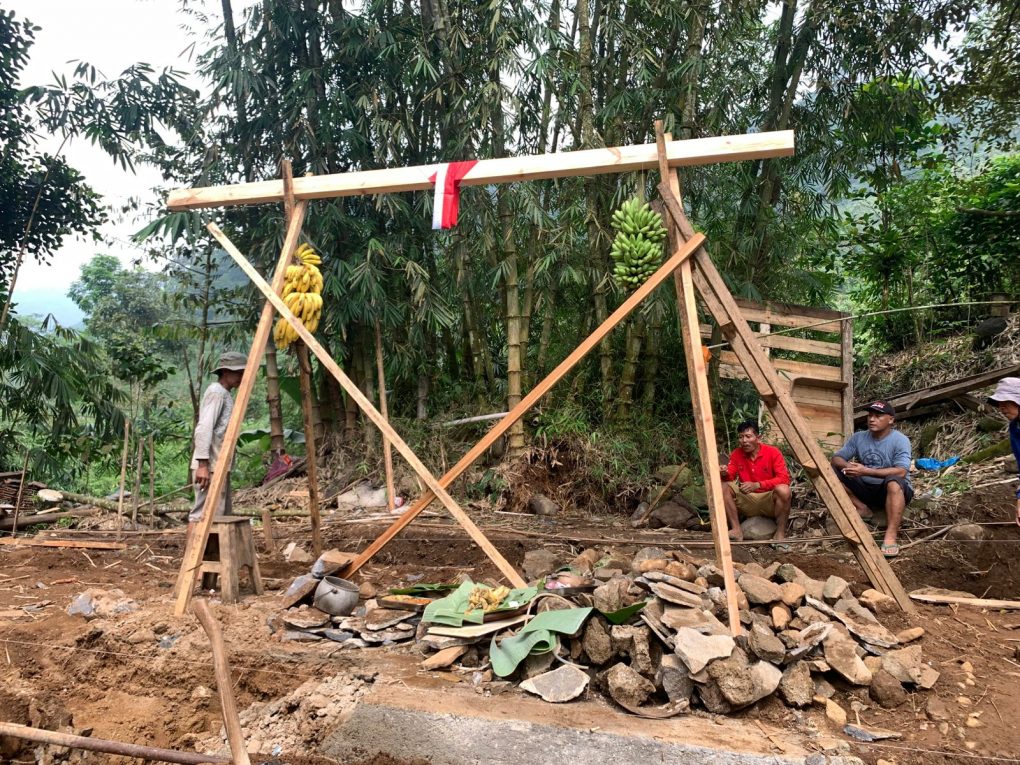by Arif Setiawan
As part of the noble tradition of the Javanese people in Petungkriyono, the *Munggah Molo* ceremony was held to mark the beginning of the construction of the SwaraOwa Conservation Education Center in Sokokembang. *Molo*, the main beam on the roof frame of the building, symbolically plays an important role as a spiritual foundation and hope for a sturdy and blessed home.
This ritual is accompanied by a joint prayer and offerings in the form of agricultural products, a symbol of gratitude and hope to the Creator and respect for the surrounding nature. In the middle of the lowland rainforest that is the habitat of the Javan gibbon, this procession marks the unification of science, local culture, and spirituality in a building that will become a growing space for conservation and learning.
June 22, 2025, marks the construction of the SwaraOwa conservation education facility, although preliminary activities of land clearing and foundation construction had begun 3 days earlier. The main part of the roof of the highest house is the spirit of the swaraOwa team to continue developing nature conservation activities that have been and are being carried out in the habitat of the Javan Gibbon. This building will later function as a front office, an information center for swaraOwa activities. We have to thanks to Fortwayne Children’s Zoo for donating for the construction of this center. the facilities included kitchen, dining room for students, coffee roasting room and cafe/souvenir shop. Managed collaboratively with local community in Sokokembang, this facilities will promote javan gibbon conservation in this region.
The symbols in the *Munggah Molo* ceremony are full of philosophical and spiritual meaning, reflecting the hope for a house that is not only physically strong, but also harmonious mentally and socially. Here are some of the main symbols commonly used in this tradition, especially in areas such as Petungkriyono:
- Sugarcane (Saccharum officinarum)
Symbolizes the *sweetness of life* and the hope that the house will be a place full of goodness and happiness. Sugarcane also reflects steadfastness and honesty.
- Rice (Oryza sativa)
Symbol of *prosperity and well-being*. Yellowing rice signifies the hope that the occupants of the house will always have their food needs met and live in abundance.
- Coconut (Cocos nucifera)
Symbolizes *wholeness and usefulness*. All parts of the coconut can be used, reflecting the hope that the house will be a useful place for the family and community.
- Indonesian Flag
Symbol of *nationalism and protection*. The red and white colors are also believed to bring positive energy and protection from supernatural disturbances. This cloth is used to wrap pounded offerings, namely dringo leaves (Artemisia vulgaris), blanke, a type of aromatic grass, and kencur (Kaempferia galanga). Which symbolizes spiritual protection, freshness, tranquility, strength and resilience for the building and its occupants.
- Coins or money
Signifies *sustenance and smooth economy*. Placed as a prayer so that the house is not lacking and is always given abundance.
- Market Snacks and Agricultural Offerings
A form of *gratitude and respect* to ancestors and the surrounding nature. This also strengthens the spiritual relationship between humans and the environment.
- Main wood- Blandar
The main wood that is raised as *molo* symbolizes *the core of life and direction of purpose*. In the context of the house, this is the spiritual foundation and a symbol that the house will be a place where noble values grow.
- One bunch of bananas
One bunch of bananas consists of many fruits that grow together on one stalk. This reflects the hope that the family occupying the new house will live in harmony, support each other, and not be separated—like bananas that remain united in one bunch. Bananas are also a symbol of blessing and abundance, a fruit that grows easily and bears many fruits. In the context of the ceremony, one bunch of bananas is a prayer that the house will always be blessed with sustenance, health, and happiness. Bananas also symbolize the continuity of life. After bearing fruit, the banana tree will die, but new shoots will grow around it. This is a symbol of hope that the house will become a place for the growth of a new generation that brings good values. One bunch of bananas is also part of the offerings as a form of respect to ancestors and the surrounding environment, asking for protection and blessings for the house that is built.
- kembang telon-triple flowers : Jasmine, Kenanga and Rose flowers.
- Other offerings : corn, tapih, kebaya clothes, placed on the molo frame, and whole ingkung chicken.
All of these offerings are then prayed for together and then eaten together with breakfast for the workers who work on building this house. These ornaments not only symbols but also a cultural narration of human relationship with nature, ancestors and God. Through this ceremony we learn a lot of our own tradition as Javanese our own roots that have been applied since many years ago by our ancestors and we hope this values could be sustainable along with our conservation activities.


